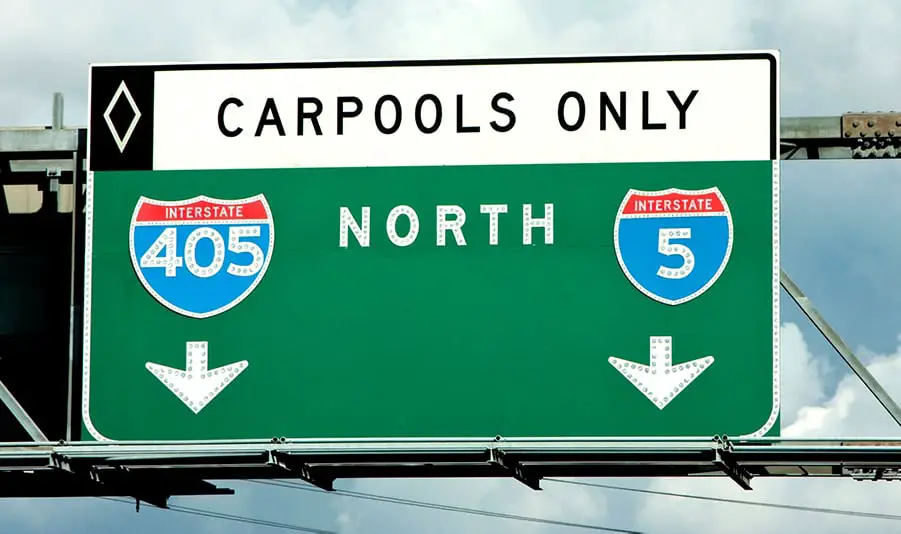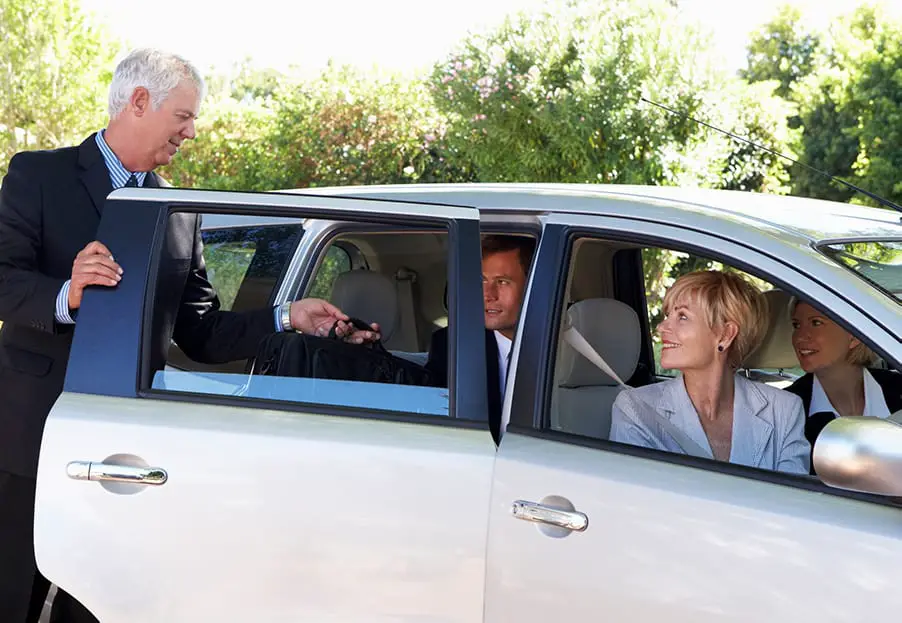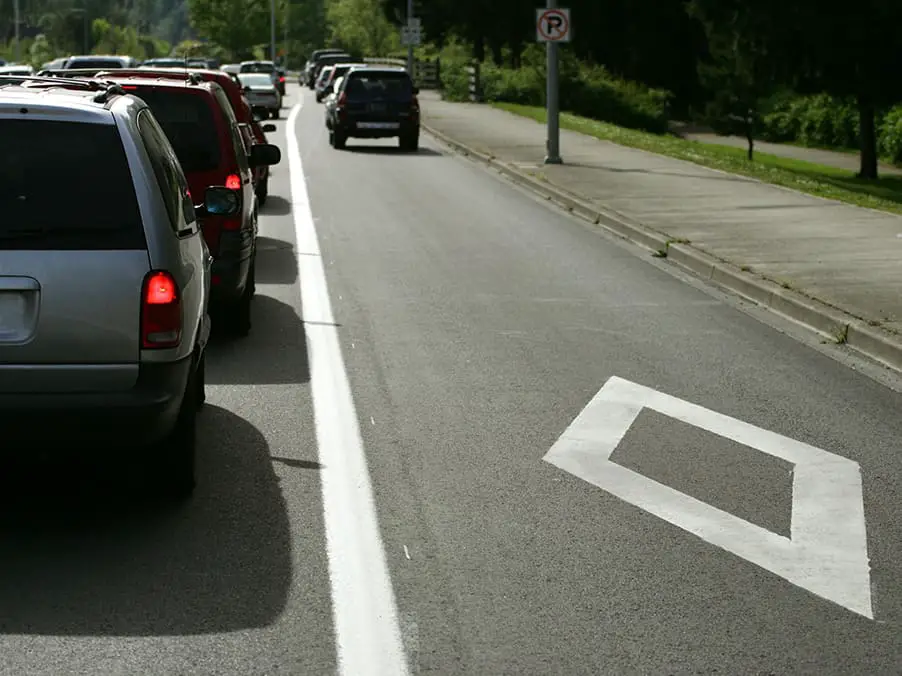
Here at True Commuter, we try to encourage life without a car as part of your daily work commute routine. We do recognise, however, that this is sometimes not practical for people with much larger commute distances, with no reasonable access to the railway network. We would always advocate the use of a multi-modal commuter method to reduce reliance on cars, but sometimes this just isn’t for everyone. Carpooling (or car-sharing) can be a great way to limit the number of cars on the road and reduce environmental impact.
Carpool lanes discourage single or low occupancy car use by providing priority to vehicles with more than a minimum number of occupants. They encourage car sharing by reducing journey times relative to single-occupancy due to a reduction in congestion in dedicated lanes.
Due to increased levels of traffic and the associated environmental impact it brings, many countries are introducing more and more carpool lanes to encourage increased vehicle occupancy and, hence, reduce the total number of vehicles on the road. Whilst carpool lanes are still few and far between in the grand scale of nationwide road networks, they are being introduced more and more on motorways and major arterial roads around the world.
Carpool lanes, alternatively referred to as High Occupancy Vehicle (HOV) lanes, diamond lanes, 2+ lanes, and transit lanes or T2 or T3 lanes, incentivise people to car share more regularly, with the deterrent of fines and fixed penalties, if these lanes are used for single-occupancy (or low-occupancy depending on the rules of the specific road) vehicles.
There are lots of configurations for carpool lanes, some of which are ‘tidal’ which means they flow differently at different parts of the day. For example, a road travelling into the city centre at morning rush hour may dedicate a lane as a designated a carpool lane, and return to the normal outside of rush hour. Conversely, a road travelling out from the city centre may create carpool lanes during the evening rush.
Effectiveness of Carpool Lanes

Carpool lanes encourage us to share our vehicles more often and as a result help to reduce congestion and harmful emissions. But do they really work? How effective is the carpool lane at encouraging multi-occupancy in vehicles and encouraging more mass transit use?
Reduced Journey Time
There are many conflicting studies about the effectiveness of carpool lanes. Many people admit to only wanting to shift to the carpool lane to avoid the congestion on the main highway. Ironically, this has the effect of reducing congestion on the highway and increasing it in the carpool lane which may discourage people from moving over. This paradox can have a detrimental impact on the effectiveness of the carpool lane. The more effective carpool lanes become, the fewer people may be encouraged to use them.
It appears from the research that people will not move to high occupancy for ethical reasons, such as environmental benefit, alone. There needs to be a personal benefit in improving the individual travel experience, mainly driven by the desire to reduce travel time. Carpool lanes claim to achieve this by reducing overall congestion, by reducing car numbers whilst increasing road capacity, and giving priority to carpool lane vehicles.
However, carpool lanes do not necessarily speed up your commute time when you consider things like, multi-person pickups, time spent waiting to be picked up and travel time combined. A unit of time, be it sat waiting, or sat in traffic was valued equally amongst a large group of surveyed individuals so carpooling for the benefit of a reduced impact on time has limited benefit.
The potential loss in flexibility you have whilst car sharing can offset any personal benefit to travelling time. Even if riding in a high-occupancy vehicle would save them 5, 15, or even 25 minutes on the freeway, many solo drivers would not make the switch.
When a current highway lane is converted to a carpool lane, this can have the effect of reducing road capacity and underutilising the road, resulting in the road being more congested. The normal lanes become more clogged up and the carpool lane has spare capacity.
Reduced Emissions
At True Commuter, we do not put as much value on commute timeframes, and like to look at the larger environmental improvements we can make by leaving the car at home. Spending more time commuting can be offset by the benefits to the environment and your personal health and wellbeing. However, it is not obvious that car-sharing reduces emissions as effectively as is often reported. The main contributor to emissions is congestion rather than the number of trips taken.
With this in mind, it would be much better to reduce overall congestion by increasing the total road capacity and fully utilising this capacity, levelling the traffic demand over the course of the day to reduce congestion peaks.
Additional Benefits of Carpooling
Carpooling has additional benefits, other than reducing travel time and improving emission. Some other benefits include:
- Improved Social Experience – you can build really good relationships and friendships whilst on your morning commute. The commute time will fly-by whilst you chat about your weekend plans or what you watched on the TV last night.
- Cost reductions – carpooling can be a great way to share the costs of commuting and running a vehicle. Sharing petrol and maintenance costs can reduce your annual outgoings significantly. Also, you will put fewer miles per year on your vehicle which will help to maintain its value.
- Reduced road wear and tear – fewer cars on the road means road maintenance requirements should reduce.
- Reduced demand for infrastructure – this may be a long way off at the moment, but it is hoped that the impact of car sharing, and use of other alternative commute methods, will enable a reduction in parking demand, reducing the impact on local authorities and city centre infrastructure.
Vehicles that Can Use The Carpool Lane

Carpools, whilst intended primarily for encouraging multiple occupancy and remove single occupancy vehicles from the road, can also be used by a number of other transportation types. This will depend a little on your local authority rules but generally the following vehicles can use the carpool lane.
- Private hire cars and taxis with a minimum number of human occupants (often two or three), including babies of any age (but only after birth) i.e. pregnant women, cannot claim to be multiple occupancies.
- Single-occupant green vehicles, such as hybrid electric vehicles, plug-in hybrids, and battery electric vehicles.
- Single-occupancy vehicles upon payment of a variable fee, such as a toll road, where applicable.
- Motorcycles – in some cases, motorcycles can use the carpool lane with a single rider, check your local regulations.
- Buses designed to transport sixteen or more passengers, including the driver.
- Public utility vehicles when responding to emergency calls.
- Bicycles.
- Police and other emergency services under certain circumstances.
How are Carpool Lanes Enforced?
If you are found to be using the carpool lane outside of the allowable use cases, the consequence in most countries will be a fine. The magnitude of punishment will depend on your local authority regulations. Road traffic police can stop you and fine you on the spot for driving in the carpool lane when you don’t qualify.
Some countries have introduced cameras that can monitor traffic and determine if a single occupancy vehicle is using the carpool lane and these are becoming more and more common as an aid to police and enforce the rules.
This hasn’t stopped people being creative to overcome the rules. It has been reported that some drivers have placed inflatable dolls in the passenger seat. This became common practise in the early introduction of carpool lanes, and still persists to some extent today, even though it is now illegal. There have been many reported cases of creative ways to attempt to unlawfully use the carpool lane, including:
- Placing mannequins, blow-up dolls, kickboxing dummies, or cardboard cut-outs in the passenger seat;
- Taping styrofoam wig stands with wigs or balloons with faces drawn on them to the passenger seat headrest;
- Buckling the passenger-side seat belt and pretending to talk to someone reclining in that seat;
- Tinting the front windshield and/or lowering the passenger side visor in an effort to obstruct the view into the passenger seat;
- Covering an empty infant seat with a blanket and/or placing a doll in it;
- Strapping dogs, cats, or other pets into the passenger seat.
Further reports have indicated that pregnant women have claimed to be ‘sharing a ride’ with their unborn baby, sorry this doesn’t count!!
How To Carpool

A carpool is simple. It’s an arrangement between two or more people to make a regular journey in a single-car, typically with each person taking turns to drive the others. However, other carpools have just one driver who drives each commute. There are no hard and fast rules – it’s up to the individual circumstances of those in your carpool. A good rule of thumb is to discuss and agree upon the cost-sharing arrangements beforehand. Determine what the driving arrangements will be if there is an equal split in driving responsibilities, and the cost-sharing arrangements.
There could be challenges to carpooling for individuals due to their personal circumstances. For instance, you may not have anybody to carpool with. Perhaps you live further from work with no other work colleagues nearby. Maybe you live out of the way, in the countryside with nobody close by. Maybe your work hours are unsociable. There are many reasons that people chose not to carpool, and instead, take their own car.
To start carpooling, you just need to find someone to carpool with. The simplest way to do that is to ask around your workplace. Does anyone who lives with you wish to carpool? Some companies offer databases of people who want to start to carpool. If your company doesn’t have this then why not start one? This can be a simple excel sheet where people register their interest in carpooling, you can download our carpool register here and use within your organisation!
Alternatively, there are many carpooling and ride share websites you can use to find an appropriate partner to carpool with from your area. This has the advantage of a larger pool of people to select for car sharing which may make it more convenient and you can find people outside of your own organisation. You will need to be comfortable with meeting new people and sharing your journey with them and it is important to be cautious here to make sure you stay safe.
Summary
Carpool lanes are there to reduce congestion on your commute and reduce overall time and stress of commuting. Carpooling is great for people where other commute alternatives, such as bike commuting or public transport, are not convenient. Carpooling can reduce the number of cars on the road and reduce your overall commute costs so it is definitely worth considering.
We are here to support you all the way so check out our other articles and resources to help you transition into a carpool arrangement.


